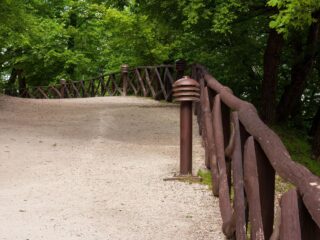
Transforming your backyard into a vibrant and inviting retreat not only enhances the aesthetic appeal of your home but also provides a personal sanctuary where you can unwind, entertain, and connect with nature. With creativity and some do-it-yourself spirit, you can reimagine your outdoor space into a place of beauty and relaxation, no matter the size or budget.
From crafting unique furniture pieces to creating lush garden beds, the possibilities are endless. Here are 15 creative projects that promise to bring new life to your backyard, making every corner a testament to your ingenuity and style.
-
Palette Patio Furniture
Creating patio furniture from wooden pallets is a cost-effective and stylish way to enhance your outdoor space. Start by sourcing materials from Challenger Pallet and other reputable pallet suppliers.
Sand the pallets to remove any rough spots and splinters, ensuring a smooth finish for safety and aesthetics. Next, apply a wood stain or sealant to protect the wood from outdoor elements and to give it a richer color.
Once dry, arrange the pallets to form the base of your furniture, such as benches or a coffee table. Secure them together with screws and add legs if desired for height. For loungers, stack pallets for a higher base and use additional pallet wood to create a reclined backrest.
Finally, add cushions in vibrant colors or weather-resistant fabric to enhance comfort and add a lively touch to your creation.
-
Vertical Garden Walls
Vertical gardens are perfect for adding greenery without taking up much ground space. Choose a wall or fence in your backyard that gets adequate sunlight.
Prepare several shelves or repurpose old wooden frames to serve as the base for your plants. Attach these horizontally across the selected wall, ensuring they are securely fastened and level.
Fill small pots or recycled containers with potting soil and plant a variety of herbs, succulents, and small flowering plants. Arrange these pots on the shelves, creating a visually appealing layout.
Ensure there’s enough space between the pots for plants to grow without overcrowding. Regular watering and care will keep your vertical garden thriving and transform your wall into a lush, living decoration.
-
DIY Fire Pit
Building a fire pit can be a simple weekend project. First, choose a safe location away from overhanging trees, bushes, or any flammable structures. Mark a circle in the ground about 4-5 feet in diameter. Remove any grass within the circle and dig a shallow pit about 12 inches deep.
Surround the pit with bricks or stones, stacking them around the edge to form a barrier. For stability and a more permanent structure, use mortar to secure the bricks or stones. Fill the base of the pit with a layer of gravel for proper drainage and top it with a layer of sand to protect the bottom from high heat.
Your fire pit is now ready for use. Always ensure to have some safety measures like a fire extinguisher or a bucket of water nearby when using the fire pit.
-
Water Features
Water features can bring a sense of peace and tranquility to your garden. Begin by choosing a container that fits the scale of your garden, such as a large pot, an old bathtub, or a wooden barrel that has been waterproofed. Essential devices used to move water from one location to another are water pumps, commonly utilized in agricultural irrigation, municipal water supply, and various industrial processes.
If you opt for a fountain, you will need to install a small submersible pump, which is available at most garden centers. Place the pump at the bottom of the container, run the power cord over the edge (or through a hole if it’s a permanent installation), and cover the base with decorative rocks and stones to conceal the equipment.
For a small pond, line the container with a PVC liner if it is not already waterproof, fill it with water, and add aquatic plants and maybe even some fish. Both types of water features can be enhanced with surrounding plants and stones to integrate them naturally into your garden.
-
Outdoor Cinema
Setting up an outdoor cinema is a fantastic way to enjoy films under the stars. First, select a flat location in your backyard where the screen can be easily viewed.
For the screen, hang a large, wrinkle-free white sheet against a flat surface or use a portable projector screen. Secure the screen tightly to avoid any movement that can distort the image.
Position a projector on a stable table or platform across from the screen, aligning it for optimal viewing. Connect the projector to your video source, such as a laptop, DVD player, or streaming device.
Arrange seating using outdoor furniture, bean bags, or even cozy blankets and pillows on the lawn. You can also add some ambient lighting with string lights or lanterns to create a magical movie night environment. Be sure to test your setup before the show to ensure everything works smoothly.
-
Bird And Butterfly Garden
Creating a bird and butterfly garden involves selecting and planting native flora that attracts these creatures. Start by researching plants native to your area that are known for attracting birds and butterflies; these often include flowering plants rich in nectar, such as milkweed, lavender, and sunflowers, and plants that produce berries like dogwood and serviceberry.
Design your garden layout by grouping plants with similar sun and water requirements. Prepare your garden beds by adding organic compost to enrich the soil, ensuring better growth. Plant the taller shrubs and trees at the back and shorter plants at the front, providing various layers of habitat.
Consider adding a water source, like a small birdbath, which will help attract more birds and butterflies. Regular maintenance—including weeding and deadheading flowers—will keep your garden healthy and vibrant, offering a dynamic display of wildlife activity.
-
Homemade Hammock
To weave a homemade hammock, start by selecting a durable material such as canvas, parachute fabric, or heavyweight cotton. You’ll need two sturdy trees or posts at a distance of about 10 to 15 feet apart, depending on the length of your hammock.
Measure and cut your fabric to the desired size, typically around 3 feet wide by 7 to 10 feet long.

Fold the ends over to create loops and sew them securely to house the ropes. Attach heavy-duty ropes or hammock straps through the loops and then around the trees or posts.
Ensure the hammock hangs at a comfortable height, usually 18 to 24 inches from the ground when you’re sitting in it. Adjust the tension to make sure it doesn’t sag excessively, ensuring a snug, secure setup for relaxation.
-
Backyard Bar
Building a backyard bar can be a rewarding project that enhances your outdoor entertainment options. Start by designing the structure; decide on dimensions and whether you want a straight, L-shaped, or circular bar.
Use recycled wood or bricks for the frame. If using wood, remember to treat it with a weather-resistant sealant. Assemble the frame, ensuring it is sturdy and level. Then, top the bar with solid materials like outdoor countertop tiles, sealed wood, or even a repurposed door.
Consider adding shelves behind the bar for storage and a footrest at the base for comfort. Personalize the bar with paint, outdoor lights, and decor to match your outdoor setting. Finally, stock your bar with beverages and glassware to serve your guests.
-
Recycled Tire Planters
To create recycled tire planters, start by collecting some old tires from a local garage or recycling center. Clean the tires thoroughly and apply a coat of outdoor paint to each, choosing bright colors for added vibrancy.
Once the paint has dried, you can stack the tires or place them individually around your garden. Fill each tire with potting soil and plant a variety of flowers, herbs, or small shrubs.
You can also cut the tires into different shapes to create more intriguing designs. These colorful tire planters not only recycle unwanted materials but also add a whimsical element to your garden décor.
-
Garden Pathways
Building garden pathways enhances the functionality and aesthetics of your outdoor space. Choose materials like stones, bricks, or wood chips, depending on the style and budget. Lay out the path by marking the ground with spray paint or a garden hose to outline the desired route.
If using stones or bricks, prepare a base by digging out the pathway to about 4 inches deep and filling it with a layer of gravel for drainage, topped with sand for leveling. Arrange the stones or bricks closely to form the path, tapping them down firmly into the sand.
For a wood chip path, simply lay landscape fabric along the route to prevent weed growth and spread wood chips over it to a depth of about 2 to 3 inches. Both styles of pathways will create charming, practical routes through your garden, enhancing the overall landscape design.
-
Shaded Seating Area
Creating a shaded seating area provides a comfortable retreat for hot summer days. Start by selecting a location in your garden that receives partial shade, ideally under trees or near taller shrubs.
If natural shade isn’t available, consider installing a pergola or a large umbrella. For the seating, use weather-resistant furniture such as wicker, metal, or treated wood. Enhance the area with outdoor rugs, cushions, and throws to add comfort and style.
You can also incorporate a small coffee table for drinks and snacks. For a more dynamic space, install outdoor curtains on a pergola, which can be drawn to block direct sunlight or provide privacy.
-
Outdoor Kitchen
An outdoor kitchen extends your home’s living space and is perfect for those who enjoy cooking and dining al fresco. Start by planning the layout, considering essential elements like a grill, countertop, and storage space.
Use weather-resistant materials such as stainless steel for appliances and natural stone or tiles for countertops. If budget allows, add a sink and a mini-fridge to keep ingredients fresh and drinks cold.

Provide adequate lighting with outdoor-safe fixtures to ensure functionality after dark. Finally, protect your investment with a cover or build a roof over the area to shield it from adverse weather.
-
Sculpture Garden
Install a sculpture garden to add artistic flair to your outdoor space. Begin by selecting sculptures that complement the style of your garden, whether abstract pieces, traditional statues, or whimsical garden ornaments.
Choose spots within your garden that serve as natural focal points or where the sculptures can be framed by plants or seen from indoor viewpoints.
Install proper bases for the sculptures to ensure they are secure and displayed to their best advantage. Consider adding spotlights to illuminate the sculptures for nighttime viewing, enhancing the ambiance of your garden.
-
Herb Spiral
An herb spiral is a compact vertical garden designed to maximize space and provide easy access to herbs. To build one, you’ll need stones, bricks, or blocks to create a spiral structure about 2 feet high and 5 feet in diameter.
Start the spiral at the center, gradually layering your materials in a circular pattern while maintaining a gentle slope. Fill the spiral with layers of gravel for drainage, followed by rich potting soil.
Plant a variety of herbs in the spiral, placing those that require less water at the top and those that need more moisture at the bottom. This structure not only saves space but also creates a visually appealing and practical feature in your garden.
-
Children’s Adventure Playground
Building a children’s adventure playground can provide endless hours of fun and stimulate their creativity. Include elements like a swing set, a slide, and a sandbox within a designated area of your garden.
Consider adding a climbing wall, rope ladders, or a zip line for older children. Surround the area with soft landscaping, such as mulch or rubber mats, to cushion falls.
Use natural materials like wood for a fort or climbing frame to blend with the outdoor environment. Ensure all structures are safe, with smooth edges and secure fittings. A dedicated play area not only keeps the children entertained but also helps them to appreciate the outdoors.
Conclusion
By undertaking these creative projects, you can transform your outdoor living space into a haven of tranquility and beauty. From crafting furniture to setting up a cozy outdoor cinema, each project contributes to a more enjoyable and functional outdoor space.
Whether you’re looking to entertain guests or simply enjoy a quiet afternoon surrounded by nature, these enhancements are sure to enrich your outdoor living experience. Let your backyard be a canvas for your creativity, and watch as it blossoms into a vibrant oasis of your own making.






